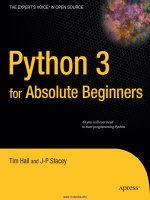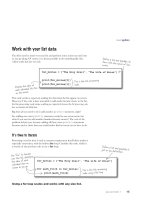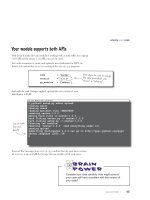Python 3 Python Installation First
Bạn đang xem bản rút gọn của tài liệu. Xem và tải ngay bản đầy đủ của tài liệu tại đây (2.38 MB, 24 trang )
sdf
Table of Contents
Introduction
1.1
Dedication
1.2
Preface
1.3
About Python
1.4
Installation
1.5
First Steps
1.6
Basics
1.7
Operators and Expressions
1.8
Control flow
1.9
Functions
1.10
Modules
1.11
Data Structures
1.12
Problem Solving
1.13
Object Oriented Programming
1.14
Input and Output
1.15
Exceptions
1.16
Standard Library
1.17
More
1.18
What Next
1.19
Appendix: FLOSS
1.20
Appendix: About
1.21
Appendix: Revision History
1.22
Appendix: Translations
1.23
Appendix: Translation How-to
1.24
Feedback
1.25
Follow me on LinkedIn for more:
Steve Nouri
/>
1
Introduction
the original text can be fetched from this location.
All the code/scripts provided in this book is licensed under the 3-clause BSD License
unless otherwise noted.
Read Now
You can read it online at />
Buy The Book
A printed hardcopy of the book can be purchased at />for your offline reading pleasure, and to support the continued development and
improvement of this book.
Download
Visit for the following types
of downloads:
PDF (for desktop reading, etc.)
EPUB (for iPhone/iPad, ebook readers, etc.)
Mobi (for Kindle)
Visit for the raw content (for suggesting
corrections, changes, translating, etc.)
Read the book in your native language
If you are interested in reading or contributing translations of this book to other human
languages, please see Translations.
9
Dedication
Dedication
To Kalyan Varma and many other seniors at PESIT who introduced us to GNU/Linux and the
world of open source.
To the memory of Atul Chitnis, a friend and guide who shall be missed greatly.
To the pioneers who made the Internet happen. This book was first written in 2003. It still
remains popular, thanks to the nature of sharing knowledge on the Internet as envisioned by
the pioneers.
10
Preface
Preface
Python is probably one of the few programming languages which is both simple and
powerful. This is good for beginners as well as for experts, and more importantly, is fun to
program with. This book aims to help you learn this wonderful language and show how to
get things done quickly and painlessly - in effect 'The Anti-venom to your programming
problems'.
Who This Book Is For
This book serves as a guide or tutorial to the Python programming language. It is mainly
targeted at newbies. It is useful for experienced programmers as well.
The aim is that if all you know about computers is how to save text files, then you can learn
Python from this book. If you have previous programming experience, then you can also
learn Python from this book.
If you do have previous programming experience, you will be interested in the differences
between Python and your favorite programming language - I have highlighted many such
differences. A little warning though, Python is soon going to become your favorite
programming language!
Official Website
The official website of the book is where you can read the
whole book online, download the latest versions of the book, buy a printed hard copy and
also send me feedback.
Something To Think About
There are two ways of constructing a software design: one way is to make it so simple
that there are obviously no deficiencies; the other is to make it so complicated that
there are no obvious deficiencies. -- C. A. R. Hoare
Success in life is a matter not so much of talent and opportunity as of concentration and
perseverance. -- C. W. Wendte
11
Preface
12
About Python
About Python
Python is one of those rare languages which can claim to be both simple and powerful. You
will find yourself pleasantly surprised to see how easy it is to concentrate on the solution to
the problem rather than the syntax and structure of the language you are programming in.
The official introduction to Python is:
Python is an easy to learn, powerful programming language. It has efficient high-level
data structures and a simple but effective approach to object-oriented programming.
Python's elegant syntax and dynamic typing, together with its interpreted nature, make
it an ideal language for scripting and rapid application development in many areas on
most platforms.
I will discuss most of these features in more detail in the next section.
Story behind the name
Guido van Rossum, the creator of the Python language, named the language after the BBC
show "Monty Python's Flying Circus". He doesn't particularly like snakes that kill animals for
food by winding their long bodies around them and crushing them.
Features of Python
Simple
Python is a simple and minimalistic language. Reading a good Python program feels almost
like reading English, although very strict English! This pseudo-code nature of Python is one
of its greatest strengths. It allows you to concentrate on the solution to the problem rather
than the language itself.
Easy to Learn
As you will see, Python is extremely easy to get started with. Python has an extraordinarily
simple syntax, as already mentioned.
Free and Open Source
13
About Python
Python is an example of a FLOSS (Free/Libré and Open Source Software). In simple terms,
you can freely distribute copies of this software, read its source code, make changes to it,
and use pieces of it in new free programs. FLOSS is based on the concept of a community
which shares knowledge. This is one of the reasons why Python is so good - it has been
created and is constantly improved by a community who just want to see a better Python.
High-level Language
When you write programs in Python, you never need to bother about the low-level details
such as managing the memory used by your program, etc.
Portable
Due to its open-source nature, Python has been ported to (i.e. changed to make it work on)
many platforms. All your Python programs can work on any of these platforms without
requiring any changes at all if you are careful enough to avoid any system-dependent
features.
You can use Python on GNU/Linux, Windows, FreeBSD, Macintosh, Solaris, OS/2, Amiga,
AROS, AS/400, BeOS, OS/390, z/OS, Palm OS, QNX, VMS, Psion, Acorn RISC OS,
VxWorks, PlayStation, Sharp Zaurus, Windows CE and PocketPC!
You can even use a platform like Kivy to create games for your computer and for iPhone,
iPad, and Android.
Interpreted
This requires a bit of explanation.
A program written in a compiled language like C or C++ is converted from the source
language i.e. C or C++ into a language that is spoken by your computer (binary code i.e. 0s
and 1s) using a compiler with various flags and options. When you run the program, the
linker/loader software copies the program from hard disk to memory and starts running it.
Python, on the other hand, does not need compilation to binary. You just run the program
directly from the source code. Internally, Python converts the source code into an
intermediate form called bytecodes and then translates this into the native language of your
computer and then runs it. All this, actually, makes using Python much easier since you don't
have to worry about compiling the program, making sure that the proper libraries are linked
and loaded, etc. This also makes your Python programs much more portable, since you can
just copy your Python program onto another computer and it just works!
14
About Python
Object Oriented
Python supports procedure-oriented programming as well as object-oriented programming.
In procedure-oriented languages, the program is built around procedures or functions which
are nothing but reusable pieces of programs. In object-oriented languages, the program is
built around objects which combine data and functionality. Python has a very powerful but
simplistic way of doing OOP, especially when compared to big languages like C++ or Java.
Extensible
If you need a critical piece of code to run very fast or want to have some piece of algorithm
not to be open, you can code that part of your program in C or C++ and then use it from your
Python program.
Embeddable
You can embed Python within your C/C++ programs to give scripting capabilities for your
program's users.
Extensive Libraries
The Python Standard Library is huge indeed. It can help you do various things involving
regular expressions,documentation generation, unit testing, threading, databases, web
browsers, CGI, FTP, email, XML, XML-RPC, HTML, WAV files, cryptography, GUI (graphical
user interfaces), and other system-dependent stuff. Remember, all this is always available
wherever Python is installed. This is called the Batteries Included philosophy of Python.
Besides the standard library, there are various other high-quality libraries which you can find
at the Python Package Index.
Summary
Python is indeed an exciting and powerful language. It has the right combination of
performance and features that make writing programs in Python both fun and easy.
Python 3 versus 2
You can ignore this section if you're not interested in the difference between "Python version
2" and "Python version 3". But please do be aware of which version you are using. This
book is written for Python version 3.
15
About Python
Remember that once you have properly understood and learn to use one version, you can
easily learn the differences and use the other one. The hard part is learning programming
and understanding the basics of Python language itself. That is our goal in this book, and
once you have achieved that goal, you can easily use Python 2 or Python 3 depending on
your situation.
For details on differences between Python 2 and Python 3, see:
The future of Python 2
Porting Python 2 Code to Python 3
Writing code that runs under both Python2 and 3
Supporting Python 3: An in-depth guide
What Programmers Say
You may find it interesting to read what great hackers like ESR have to say about Python:
Eric S. Raymond is the author of "The Cathedral and the Bazaar" and is also the person
who coined the term Open Source. He says that Python has become his favorite
programming language. This article was the real inspiration for my first brush with
Python.
Bruce Eckel is the author of the famous 'Thinking in Java' and 'Thinking in C++' books.
He says that no language has made him more productive than Python. He says that
Python is perhaps the only language that focuses on making things easier for the
programmer. Read the complete interview for more details.
Peter Norvig is a well-known Lisp author and Director of Search Quality at Google
(thanks to Guido van Rossum for pointing that out). He says that writing Python is like
writing in pseudocode. He says that Python has always been an integral part of Google.
You can actually verify this statement by looking at the Google Jobs page which lists
Python knowledge as a requirement for software engineers.
16
Installation
Installation
When we refer to "Python 3" in this book, we will be referring to any version of Python equal
to or greater than version Python 3.6.0.
Installation on Windows
Visit and download the latest version. At the time of this
writing, it was Python 3.5.1 The installation is just like any other Windows-based software.
Note that if your Windows version is pre-Vista, you should download Python 3.4 only as later
versions require newer versions of Windows.
CAUTION: Make sure you check option
To change install location, click on
C:\python35
Add Python 3.5 to PATH
Customize installation
.
, then
Next
and enter
(or another appropriate location) as the install location.
If you didn t check the
environment variables
Add Python 3.5 PATH
option earlier, check
. This does the same thing as
Add Python to
Add Python 3.5 to PATH
on the first
install screen.
You can choose to install Launcher for all users or not, it does not matter much. Launcher is
used to switch between different versions of Python installed.
If your path was not set correctly (by checking the
environment variables
it. Otherwise, go to the
Add Python 3.5 Path
or
options), then follow the steps in the next section (
Running Python prompt on Windows
Add Python to
DOS Prompt
) to fix
section in this document.
NOTE: For people who already know programming, if you are familiar with Docker, check
out Python in Docker and Docker on Windows.
DOS Prompt
If you want to be able to use Python from the Windows command line i.e. the DOS prompt,
then you need to set the PATH variable appropriately.
For Windows 2000, XP, 2003 , click on
Environment Variables
then select
Edit
Control Panel
. Click on the variable named
and add
;C:\Python35
->
PATH
System
->
Advanced
->
in the System Variables section,
(please verify that this folder exists, it will be
17
Installation
different for newer versions of Python) to the end of what is already there. Of course, use the
appropriate directory name.
For older versions of Windows, open the file
C:\AUTOEXEC.BAT
and add the line
and restart the system. For Windows NT, use the
PATH=%PATH%;C:\Python35
AUTOEXEC.NT
file.
For Windows Vista:
Click Start and choose
Control Panel
Click System, on the right you'll see "View basic information about your computer"
On the left is a list of tasks, the last of which is
The
Advanced
Variables
tab of the
System Properties
. Click that.
Advanced system settings
dialog box is shown. Click the
Environment
button on the bottom right.
In the lower box titled
System Variables
scroll down to Path and click the
Edit
button.
Change your path as need be.
Restart your system. Vista didn't pick up the system path environment variable change
until I restarted.
For Windows 7 and 8:
Right click on Computer from your desktop and select
choose
Control Panel
settings
->
System and Security
on the left and then click on the
Environment Variables
and then press
Edit
and under
->
Properties
System
Advanced
or click
. Click on
Start
and
Advanced system
tab. At the bottom click on
System variables
, look for the
PATH
variable, select
.
Go to the end of the line under Variable value and append
;C:\Python35
(please verify
that this folder exists, it will be different for newer versions of Python) to the end of what
is already there. Of course, use the appropriate folder name.
If the value was
%SystemRoot%\system32;
It will now become
%SystemRoot%\system32;C:\Python36
Click
OK
and you are done. No restart is required, however you may have to close and
reopen the command line.
For Windows 10:
Windows Start Menu >
right) >
Settings
Advanced System Settings
(then highlight
Path
>
>
About
System Info
Environment Variables
variable and click
location is. For example,
>
C:\Python35\
Edit
)>
New
(this is all the way over to the
(this is towards the bottom) >
> (type in whatever your python
)
Running Python prompt on Windows
18
Installation
For Windows users, you can run the interpreter in the command line if you have set the
PATH
variable appropriately.
To open the terminal in Windows, click the start button and click
cmd
and press
Then, type
[enter]
python
Run
. In the dialog box, type
key.
and ensure there are no errors.
Installation on Mac OS X
For Mac OS X users, use Homebrew:
To verify, open the terminal by pressing
type
and press
Terminal
[enter]
.
brew install python3
[Command + Space]
key. Now, run
python3
keys (to open Spotlight search),
and ensure there are no errors.
Installation on GNU/Linux
For GNU/Linux users, use your distribution's package manager to install Python 3, e.g. on
Debian & Ubuntu:
sudo apt-get update && sudo apt-get install python3
To verify, open the terminal by opening the
and entering
gnome-terminal
Terminal
.
application or by pressing
Alt + F2
. If that doesn't work, please refer the documentation of your
particular GNU/Linux distribution. Now, run
python3
and ensure there are no errors.
You can see the version of Python on the screen by running:
$ python3 -V
Python 3.6.0
NOTE:
$
is the prompt of the shell. It will be different for you depending on the settings of
the operating system on your computer, hence I will indicate the prompt by just the
$
symbol.
CAUTION: Output may be different on your computer, depending on the version of Python
software installed on your computer.
Summary
From now on, we will assume that you have Python installed on your system.
Next, we will write our first Python program.
19
Installation
20
First Steps
First Steps
We will now see how to run a traditional 'Hello World' program in Python. This will teach you
how to write, save and run Python programs.
There are two ways of using Python to run your program - using the interactive interpreter
prompt or using a source file. We will now see how to use both of these methods.
Using The Interpreter Prompt
Open the terminal in your operating system (as discussed previously in the Installation
chapter) and then open the Python prompt by typing
Once you have started Python, you should see
>>>
python3
and pressing
[enter]
key.
where you can start typing stuff. This is
called the Python interpreter prompt.
At the Python interpreter prompt, type:
print("Hello World")
followed by the
[enter]
key. You should see the words
Hello World
printed to the screen.
Here is an example of what you should be seeing, when using a Mac OS X computer. The
details about the Python software will differ based on your computer, but the part from the
prompt (i.e. from
>>>
onwards) should be the same regardless of the operating system.
$ python3
Python 3.6.0 (default, Jan 12 2017, 11:26:36)
[GCC 4.2.1 Compatible Apple LLVM 8.0.0 (clang-800.0.38)] on darwin
Type "help", "copyright", "credits" or "license" for more information.
>>> print("Hello World")
Hello World
Notice that Python gives you the output of the line immediately! What you just entered is a
single Python statement. We use
to it. Here, we are supplying the text
to (unsurprisingly) print any value that you supply
Hello World
and this is promptly printed to the screen.
How to Quit the Interpreter Prompt
21
First Steps
If you are using a GNU/Linux or OS X shell, you can exit the interpreter prompt by pressing
[ctrl + d]
by the
or entering
[enter]
exit()
(note: remember to include the parentheses,
()
) followed
key.
If you are using the Windows command prompt, press
[ctrl + z]
followed by the
[enter]
key.
Choosing An Editor
We cannot type out our program at the interpreter prompt every time we want to run
something, so we have to save them in files and can run our programs any number of times.
To create our Python source files, we need an editor software where you can type and save.
A good programmer's editor will make your life easier in writing the source files. Hence, the
choice of an editor is crucial indeed. You have to choose an editor as you would choose a
car you would buy. A good editor will help you write Python programs easily, making your
journey more comfortable and helps you reach your destination (achieve your goal) in a
much faster and safer way.
One of the very basic requirements is syntax highlighting where all the different parts of your
Python program are colorized so that you can see your program and visualize its running.
If you have no idea where to start, I would recommend using PyCharm Educational Edition
software which is available on Windows, Mac OS X and GNU/Linux. Details in the next
section.
If you are using Windows, do not use Notepad - it is a bad choice because it does not do
syntax highlighting and also importantly it does not support indentation of the text which is
very important in our case as we will see later. Good editors will automatically do this.
If you are an experienced programmer, then you must be already using Vim or Emacs.
Needless to say, these are two of the most powerful editors and you will benefit from using
them to write your Python programs. I personally use both for most of my programs, and
have even written an entire book on Vim.
In case you are willing to take the time to learn Vim or Emacs, then I highly recommend that
you do learn to use either of them as it will be very useful for you in the long run. However,
as I mentioned before, beginners can start with PyCharm and focus the learning on Python
rather than the editor at this moment.
To reiterate, please choose a proper editor - it can make writing Python programs more fun
and easy.
22
First Steps
PyCharm
PyCharm Educational Edition is a free editor which you can use for writing Python programs.
When you open PyCharm, you'll see this, click on
Select
Pure Python
Create New Project
:
:
23
First Steps
Change
untitled
to
helloworld
as the location of the project, you should see details
similar to this:
24
First Steps
Click the
Create
Right-click on the
button.
helloworld
in the sidebar and select
New
->
Python File
:
25
First Steps
You will be asked to type the name, type
hello
:
You can now see a file opened for you:
26
First Steps
Delete the lines that are already present, and now type the following:
print("hello world")
Now right-click on what you typed (without selecting the text), and click on
Run 'hello'
.
27
First Steps
You should now see the output (what it prints) of your program:
Phew! That was quite a few steps to get started, but henceforth, every time we ask you to
create a new file, remember to just right-click on
File
helloworld
on the left ->
New
->
Python
and continue the same steps to type and run as shown above.
You can find more information about PyCharm in the PyCharm Quickstart page.
Vim
1. Install Vim
Mac OS X users should install
macvim
package via HomeBrew
Windows users should download the "self-installing executable" from Vim website
GNU/Linux users should get Vim from their distribution's software repositories, e.g.
Debian and Ubuntu users can install the
vim
package.
2. Install jedi-vim plugin for autocompletion.
3. Install corresponding
jedi
python package :
pip install -U jedi
Emacs
1. Install Emacs 24+.
Mac OS X users should get Emacs from
Windows users should get Emacs from />28
First Steps
GNU/Linux users should get Emacs from their distribution's software repositories,
e.g. Debian and Ubuntu users can install the
emacs24
package.
2. Install ELPY
Using A Source File
Now let's get back to programming. There is a tradition that whenever you learn a new
programming language, the first program that you write and run is the 'Hello World' program
1
- all it does is just say 'Hello World' when you run it. As Simon Cozens says, it is the
"traditional incantation to the programming gods to help you learn the language better."
Start your choice of editor, enter the following program and save it as
hello.py
.
If you are using PyCharm, we have already discussed how to run from a source file.
For other editors, open a new file
hello.py
and type this:
print("hello world")
Where should you save the file? To any folder for which you know the location of the folder.
If you don't understand what that means, create a new folder and use that location to save
and run all your Python programs:
/tmp/py
on Mac OS X
/tmp/py
on GNU/Linux
C:\py
on Windows
To create the above folder (for the operating system you are using), use the
command in the terminal, for example,
mkdir /tmp/py
.
IMPORTANT: Always ensure that you give it the file extension of
foo.py
mkdir
.py
, for example,
.
To run your Python program:
1. Open a terminal window (see the previous Installation chapter on how to do that)
2. Change directory to where you saved the file, for example,
3. Run the program by entering the command
python hello.py
cd /tmp/py
. The output is as shown
below.
$ python hello.py
hello world
29
First Steps
If you got the output as shown above, congratulations! - you have successfully run your first
Python program. You have successfully crossed the hardest part of learning programming,
which is, getting started with your first program!
In case you got an error, please type the above program exactly as shown above and run
the program again. Note that Python is case-sensitive i.e.
- note the lowercase
p
in the former and the uppercase
P
is not the same as
in the latter. Also, ensure there
are no spaces or tabs before the first character in each line - we will see why this is
important later.
How It Works
A Python program is composed of statements. In our first program, we have only one
statement. In this statement, we call the
statement to which we supply the text "hello
world".
Getting Help
If you need quick information about any function or statement in Python, then you can use
the built-in
help
functionality. This is very useful especially when using the interpreter
prompt. For example, run
help('len')
- this displays the help for the
len
function which is
used to count number of items.
30
First Steps
TIP: Press
q
to exit the help.
Similarly, you can obtain information about almost anything in Python. Use
more about using
help
to learn
itself!
In case you need to get help for operators like
quotes such as
help()
help('return')
return
, then you need to put those inside
so that Python doesn't get confused on what we're trying to
do.
Summary
You should now be able to write, save and run Python programs at ease.
Now that you are a Python user, let's learn some more Python concepts.
1
. the author of the amazing 'Beginning Perl' book ↩
31









